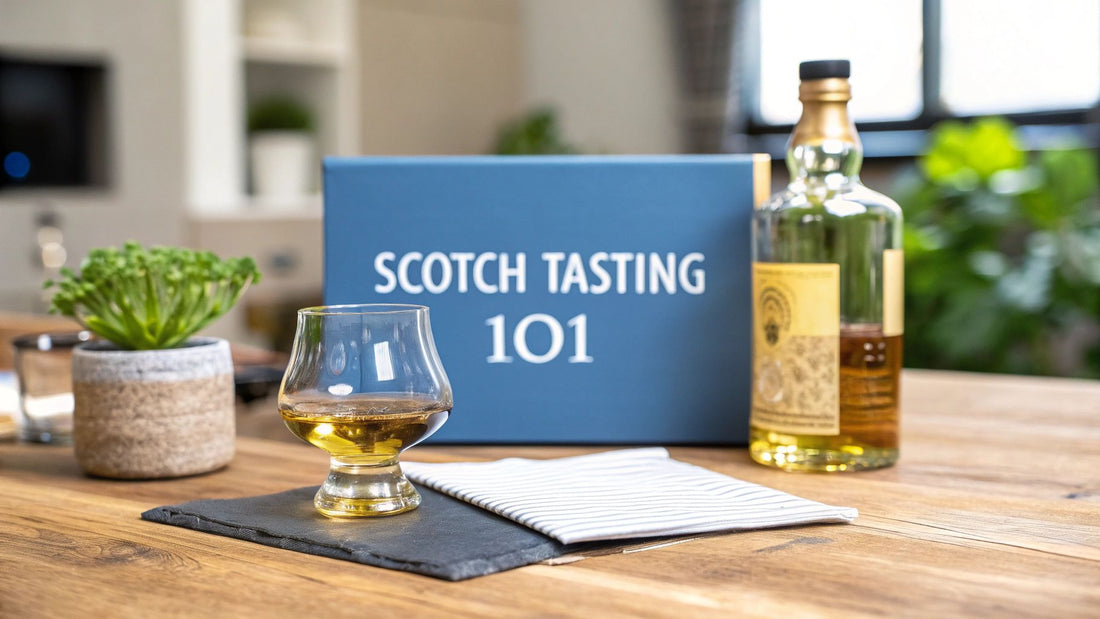Ready to dive into the world of Scotch? It can feel a bit intimidating at first, but it's really a fantastic journey built on centuries of Scottish tradition. Forget any complicated rules you might have heard—the goal here is simply to find what you enjoy. A great tip for new whiskey drinkers is to start with an open mind and be ready to explore.
At its core, Scotch is just whisky made in Scotland. It's typically crafted from malted barley and then aged in oak casks for a minimum of three years. That's the foundation. Understanding that simple fact is the first step to feeling more comfortable as you start exploring.
Starting Your Scotch Journey With Confidence
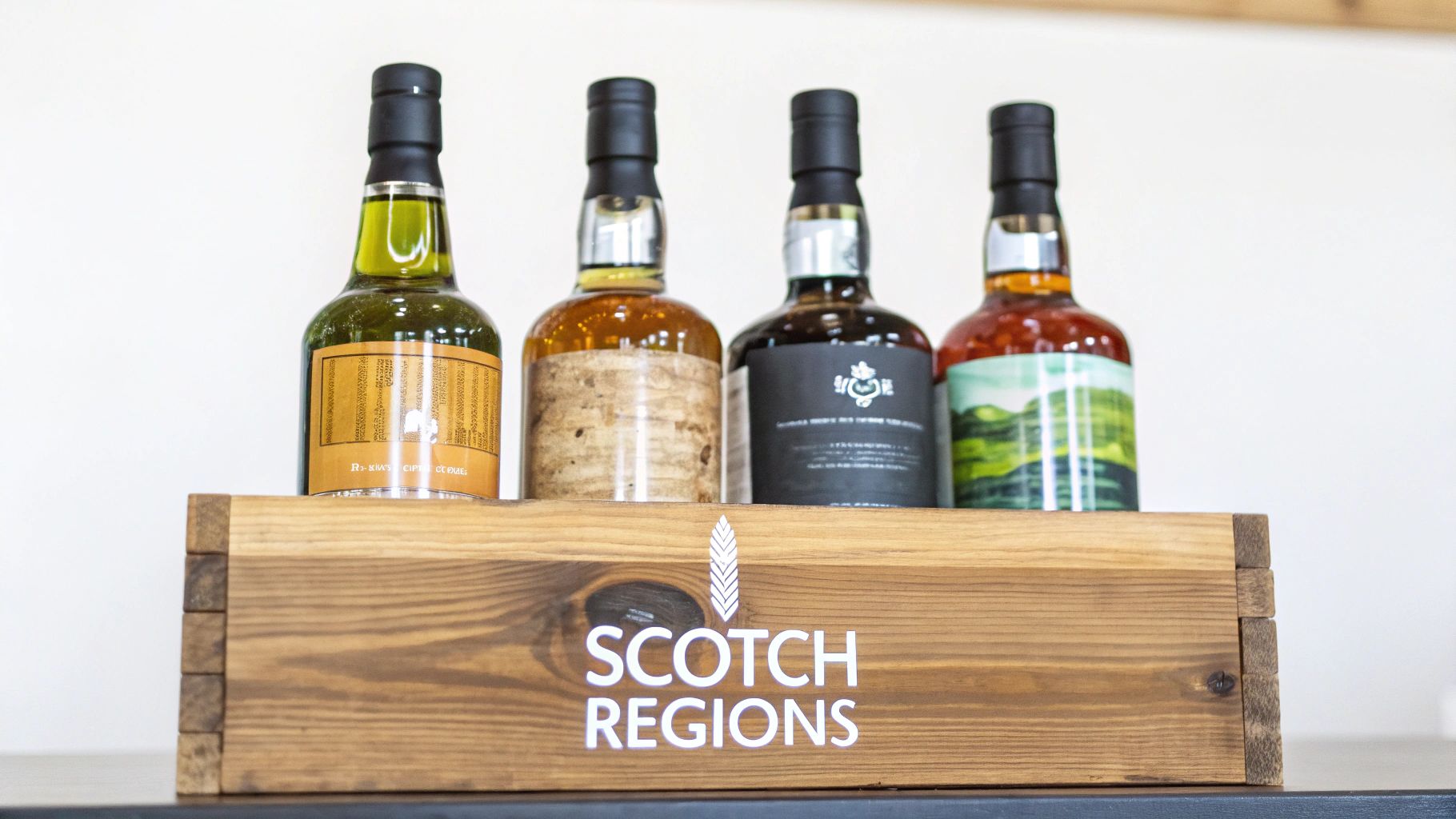
The biggest question beginners usually ask is about the difference between the main styles. It's much simpler than it sounds.
- Single Malt Scotch comes from just one distillery and is made from 100% malted barley. This gives it a unique character that really reflects where it was made. Think of it as having a distinct personality.
- Blended Scotch is a mix of whiskies from several different distilleries. Blends are intentionally crafted for a consistent and often smoother, more approachable flavor profile.
Globally, the Scotch whisky market is massive, valued at around USD 33.5 billion. You might be surprised to learn that Blended Scotch dominates sales, making up about 85% of the market, with single malts covering most of the rest. This just goes to show how popular and easy-to-drink blends are for people all over the world. If you're curious, you can find more details on Scotch market trends and consumer tastes on cognitivemarketresearch.com.
Your Beginner's Scotch Starter Kit
Getting started doesn't mean you need a cabinet packed with expensive gear. Honestly, all you really need is a decent glass and a thoughtfully chosen bottle. Here are a few solid recommendations to get you pouring your first dram with ease.
| Item Type | Recommendation | Why It's Good for Beginners |
|---|---|---|
| Glassware | A Glencairn glass or a simple tumbler (rocks glass) | The Glencairn's tulip shape is fantastic for concentrating aromas, but a basic tumbler works perfectly fine when you're just starting. |
| Single Malt | Glenmorangie 10 or Glenfiddich 12 | Both are classic Speyside malts known for being light, fruity, and incredibly smooth, without any overwhelming smoke or peat. |
| Blended Scotch | Johnnie Walker Black Label or Monkey Shoulder | These are well-balanced, approachable blends that give you a taste of different Scotch styles all in one smooth, easy-drinking package. |
This simple setup is more than enough to begin your journey. The key is to start with whiskies that are known for being welcoming to new palates, allowing you to build your appreciation from there.
How to Choose Your First Bottle of Scotch
Walking into a liquor store and seeing a wall of Scotch can be seriously intimidating. My advice? Forget trying to decipher the fancy labels for now. Instead, just ask yourself one simple question: what kinds of flavors do I already like? The answer is your secret map to finding a bottle you'll genuinely enjoy.
Thinking about flavor profiles is really the best way to get started. Are you someone who leans toward sweet and fruity things? Maybe light and delicate? Or are you feeling a bit more adventurous and want to try something with a bit of smoke? Your answer points you directly to one of Scotland’s famous whisky-producing regions.
This little guide is a great way to match your tastes to a region.
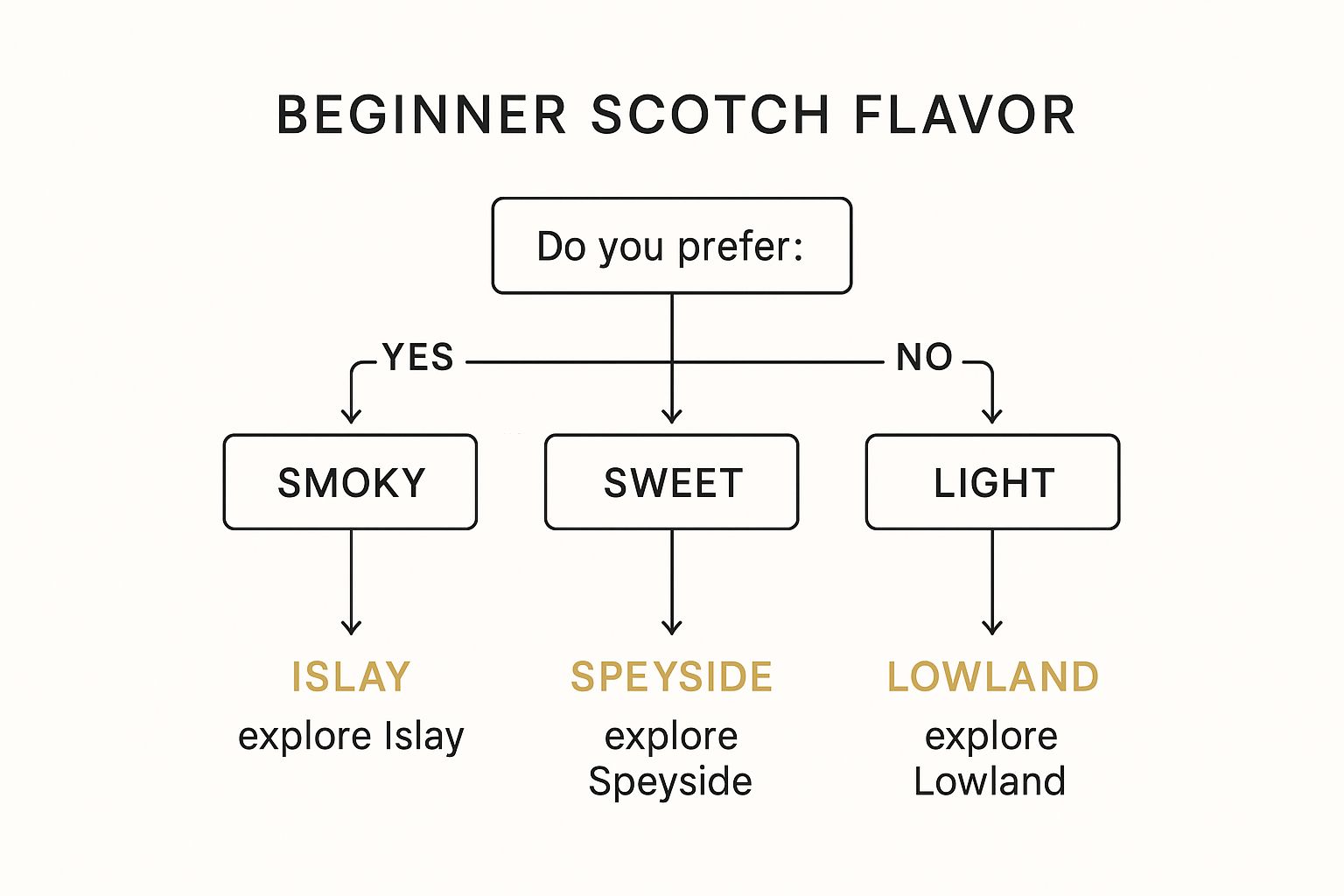
As you can see, it all comes down to your personal preference. That's the best compass you have for navigating the world of Scotch.
Finding Your Flavor Profile
So, what do these regional styles actually mean for the bottle you’re about to buy? Each area has its own signature character, which makes it much easier to know what you're getting into.
- Speyside (Sweet & Fruity): This region is famous for its smooth, incredibly approachable whiskies. Think notes of apple, honey, and vanilla. Honestly, it's a perfect place to start.
- Lowlands (Light & Gentle): If you're looking for something more delicate, Lowland scotches are your best bet. They’re often grassy and floral without any of that aggressive smoke.
- Islay (Smoky & Peaty): For those with an adventurous palate, Islay is where the action is. These whiskies deliver bold, smoky, and sometimes medicinal flavors that come from peat—the mossy fuel used to dry the barley. It's a love-it-or-hate-it kind of thing, but when it clicks, it really clicks.
The United States is actually the largest export market for Scotch, with a strong preference for single malts, especially from the Speyside region. This just goes to show how popular these accessible, flavorful whiskies are with drinkers who appreciate craftsmanship and variety.
If you’re already a fan of American whiskeys, you can find some familiar comfort in Scotch. Do you love the rich sweetness of a good bourbon? A sherry cask-finished Speyside single malt will probably be right up your alley.
Or maybe you enjoy the robust character of American craft whiskeys from distilleries like Westland or Balcones? In that case, you might really appreciate a moderately peated Highland scotch. For a deeper dive, check out these single malt whiskey recommendations that can help bridge the gap.
Ultimately, choosing your first bottle is all about connecting what you already know you like to the exciting new world of Scotch.
The Art of Tasting and Finding Flavors
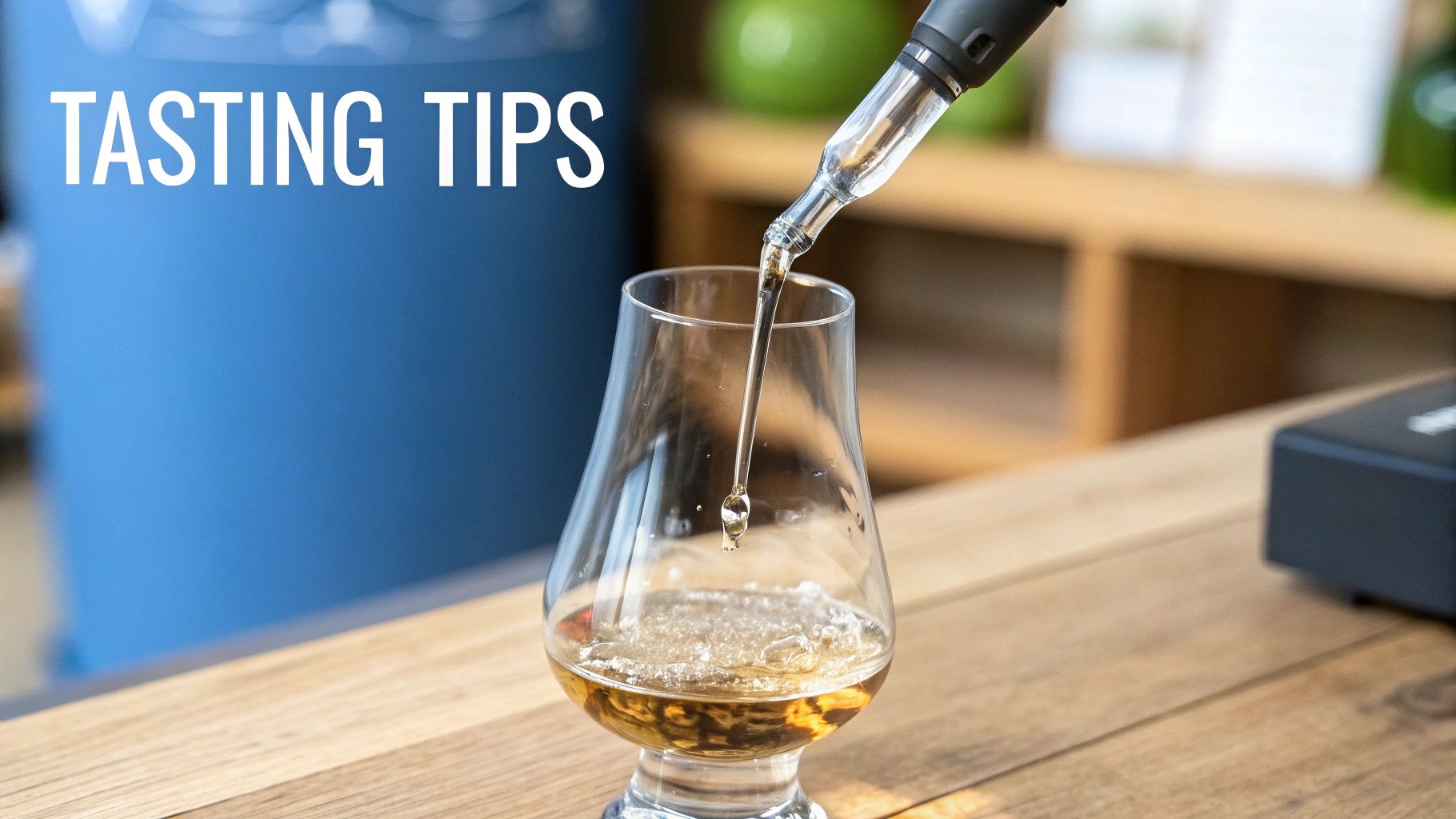
There’s a world of difference between just drinking Scotch and truly tasting it. This simple shift in mindset is what unlocks the incredible depth hiding in your glass, turning a simple drink into a full sensory experience. It all starts before the whisky even hits your lips.
Your journey into tasting Scotch properly begins with the right glass. Sure, any tumbler will do in a pinch, but a tulip-shaped glass like the iconic Glencairn is purpose-built for the job. Its design concentrates the whisky’s aromas, funneling them straight to your nose. It's a small change that makes a massive difference.
How to Properly Nose Your Scotch
Before you take that first sip, you have to "nose" the whisky. This isn't just some snobby ritual; over 80% of what we perceive as taste is actually smell. This step is where you’ll discover the Scotch's real personality. But please, don't just stick your nose deep into the glass and take a huge whiff—that's a surefire way to get a harsh blast of alcohol and singe your nostrils.
Instead, let’s do it the right way:
- Keep Your Distance: Hold the glass a few inches from your nose. Give it a gentle swirl to get the liquid moving and release all those aromatic compounds.
- Breathe Gently: Bring the glass a little closer and take short, soft sniffs. A great trick is to breathe in through your nose with your mouth slightly open. This helps circulate the air and really softens any alcohol burn.
- Identify the Aromas: What are you smelling? Don't stress about finding obscure notes right away. Think in broad categories first. Is it fruity, floral, spicy, or smoky? Once you have that, then you can dig deeper. Is that fruitiness like a crisp green apple or more like dried figs? Is the smoke reminiscent of a campfire or a freshly struck match?
A pro tip for anyone new to this is to alternate nostrils. It sounds strange, but each nostril can pick up slightly different scent profiles, giving you a much more complete picture of what's in the glass.
The First Sip and Finding Flavors
Alright, now for the main event—the tasting. The key here is to take a small sip and let it coat your entire tongue before you swallow. In the American whiskey world, they call this the "Kentucky Chew," and the principle works just as well for Scotch.
That first sip might still feel a little hot from the alcohol. That's perfectly normal, so don't be discouraged. The second sip is where the magic really happens. Your palate is now primed and more accustomed to the proof, which allows the deeper, more complex flavors to finally come through.
Pay attention to the journey the flavor takes across your palate. Does it start sweet and then turn spicy on the finish? Can you pick out notes of vanilla, caramel, oak, or maybe a bit of citrus? A great tip for new whiskey drinkers is to write down a few notes. You don't need to be a poet; simple words like "sweet," "smoky," or "spicy" help you remember what you like.
Finding Your Perfect Pour: Neat, Water, or Ice?
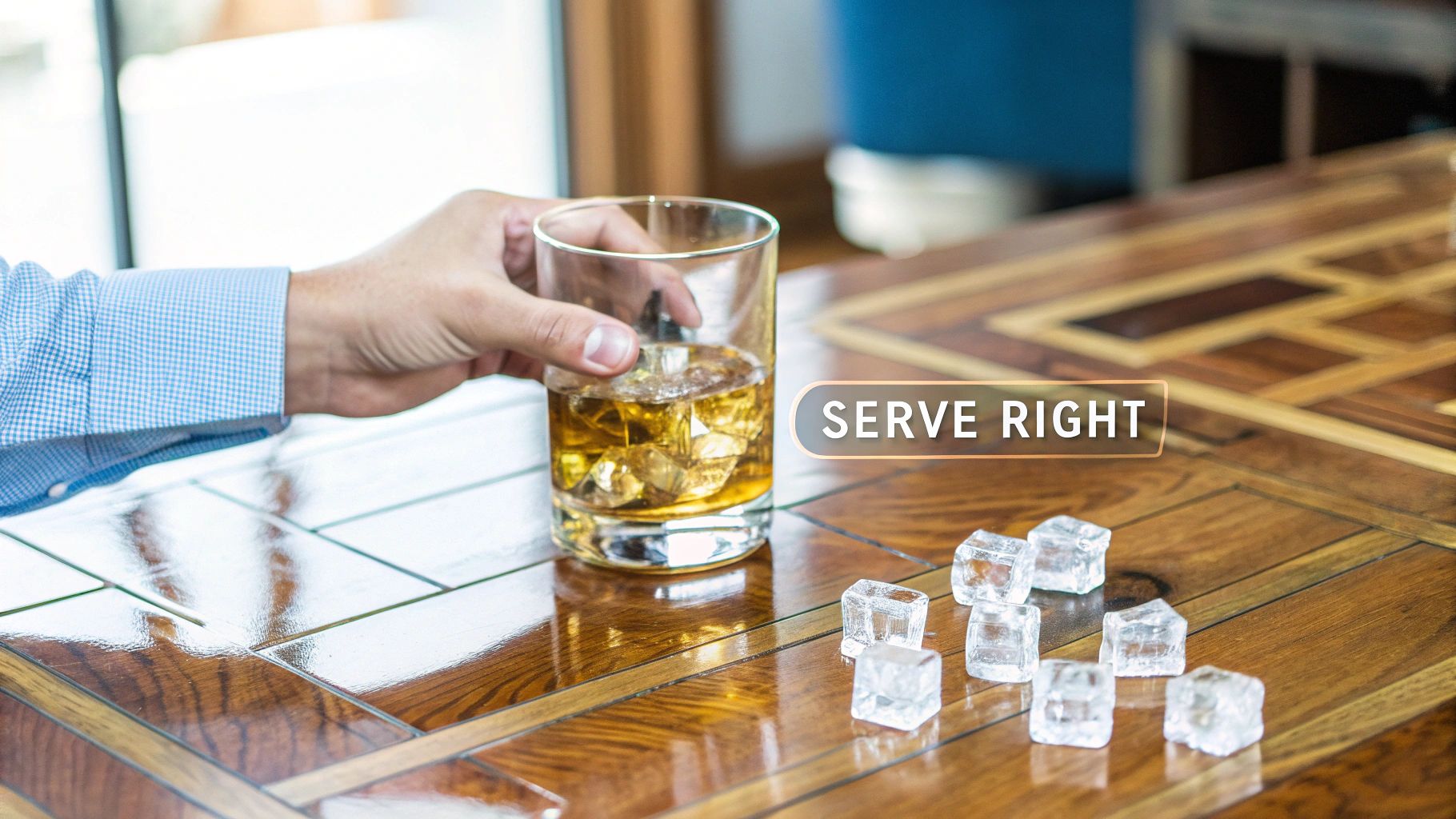
Forget any rigid rules you might have heard about drinking Scotch. The single most important factor is your enjoyment, and the only way to figure out what you like is to experiment. This is all about finding your perfect serve, judgment-free.
Many purists will tell you the only way to drink Scotch is neat—with nothing added at all. And they have a point. This is a fantastic way to experience the whisky exactly as the distiller intended, tasting its unaltered character straight from the bottle.
But don't stop there. Adding just a few drops of room-temperature water can completely transform the experience. This simple act causes a chemical reaction that lowers the alcohol's intensity and "opens up" the spirit, unlocking subtle aromas and flavors that were previously hiding behind the alcohol burn.
To Chill or Not to Chill
Adding ice, or serving your Scotch "on the rocks," is a popular but sometimes debated method. If you go this route, a single, large ice cube or sphere is your best friend. It melts much slower than smaller cubes, chilling the drink with minimal dilution.
Ice is a great tool for taming a particularly harsh or high-proof whisky, making it more refreshing and mellow on a warm day. Just be aware that extreme cold can numb your taste buds a bit, potentially muting some of the more delicate notes in a complex single malt.
A great tip for anyone new to whiskey is to try a new bottle three ways. Pour a small amount and taste it neat first. Then, add a few drops of water and taste it again. Finally, drop in a large ice cube. This little process lets you experience the full spectrum of what a single whisky has to offer.
For those curious about cocktails, classics like a Penicillin or a Rob Roy are specifically designed to let the Scotch shine through. And if you're interested in the finer points of dilution, you can learn more about the role of water in whiskey in our detailed article.
Ultimately, this is your journey. Don't be afraid to try different approaches to find what you truly enjoy.
Pairing Scotch With Your Favorite Foods
Forget thinking of Scotch as just a standalone drink. It's a fantastic partner for a meal, capable of elevating flavors in some truly surprising ways. Moving on to food pairings is a natural next step for anyone new to drinking scotch, turning a simple tasting into a full-on culinary experience.
The secret? It’s all about matching intensity. A light, delicate Scotch will get completely steamrolled by a heavy, rich dish. On the other hand, a bold, smoky whisky needs a food that can hold its own. It's a balancing act on your palate.
For example, a lot of American craft whiskeys, especially single malts from distilleries like Westward, are aged in unique casks that give them distinct fruity or spicy notes. A lighter craft single malt with those classic apple and honey flavors? That’s a brilliant match for creamy goat cheese or a simple charcuterie board.
Your Scotch And Food Pairing Cheat Sheet
To keep things simple, just think back to the regional profiles. Every style has its own natural food affinities that are easy to remember and honestly, a lot of fun to explore. This quick guide will get you started with some classic combos.
| Scotch Region/Style | Flavor Profile | Pairs Well With |
|---|---|---|
| Lowland | Light, floral, grassy | Fresh seafood like oysters, sushi, or light salads with vinaigrette. |
| Speyside | Fruity, sweet, honeyed | Desserts like apple pie, dark chocolate, or a rich crème brûlée. |
| Highland | Diverse, robust, often a balance of fruit and smoke | Roasted chicken, mild sausages, or aged cheddar cheese. |
| Islay | Smoky, peaty, briny | Grilled steak, smoked salmon, strong blue cheese, or even BBQ ribs. |
This table is your starting point, not the final word. The real magic happens when you start experimenting.
Here's a great tip for anyone new to this: start with a classic pairing like a rich Speyside malt and a single square of 70% dark chocolate. The whisky’s fruity sweetness cuts right through the chocolate's bitterness, creating an incredible flavor combination you won't soon forget.
Don't be afraid to experiment with your favorite meals. The amazing versatility of Scotch is a huge part of its charm. For a deeper dive, check out our guide on pairing food with whiskey, which is packed with even more ideas to try at home.
Got Questions About Scotch? We've Got Answers.
When you're first dipping your toes into the world of Scotch, it’s only natural for questions to pop up. It’s a complex spirit, after all! Here are some straightforward answers to the things beginners wonder about the most.
Scotch, Bourbon, Whiskey... What's The Deal?
This is probably the most classic question out there, and for good reason. Think of whiskey as the overarching family name, like "car." Scotch and Bourbon are specific models within that family, like a rugged truck or a sleek sedan.
They all start as grain spirits, but the rules they have to follow are what make them so different.
- Scotch is a purist. It must be made in Scotland, almost always from malted barley, and then aged for a minimum of three years in oak barrels.
- Bourbon, on the other hand, is America's native spirit. It has to be made from at least 51% corn and must be aged in brand new, charred oak barrels.
So, while all Scotch and all Bourbon are technically types of whiskey, their unique "rules of the road" give them completely different personalities and flavor profiles.
How Do I Read The Age Statement On a Bottle?
When you see a number like "12 Years Old" on a Scotch bottle, that number represents the age of the absolute youngest whisky that went into that bottle.
Scotch often involves blending whiskies of various ages to achieve a specific flavor profile. So, a 12-year-old bottle might contain whisky that's 15, 20, or even older, but the youngest drop in that blend is guaranteed to be at least 12 years old.
It's easy to fall into the trap of thinking older always means better. Age can certainly add complexity and mellow out a spirit, but it’s not the whole story. A vibrant, well-crafted younger whisky can be just as incredible.
Are Peat and Smoke The Same Thing?
They're two sides of the same coin. Peat is essentially compacted, decomposed vegetation—think ancient, earthy moss—that's been dug up from the ground.
On islands like Islay, some distilleries still use this peat as a fuel source to dry their malted barley. As the peat smolders, its intensely aromatic smoke gets absorbed by the grain. That smoky, earthy, and sometimes medicinal flavor is what sticks with the barley all the way through distillation and aging, right into your glass.
This signature smokiness is what makes Islay Scotches so famous and beloved. It's a taste that's celebrated worldwide, contributing to a massive global appetite for Scotch. To give you some perspective, India recently became the world's top consumer, putting away around 85 million bottles in just the first half of a single year. You can dive deeper into these global Scotch consumption trends on alushlifemanual.com.
At Blind Barrels, we're firm believers that the best way to figure out what you love is simply by tasting. Our blind whiskey tasting subscription is designed to help you do just that, removing brand bias so your palate can do the talking. We feature amazing selections from some of America's best craft distilleries. Ready to find your next favorite? Visit us at https://www.blindbarrels.com.
Article created using Outrank
